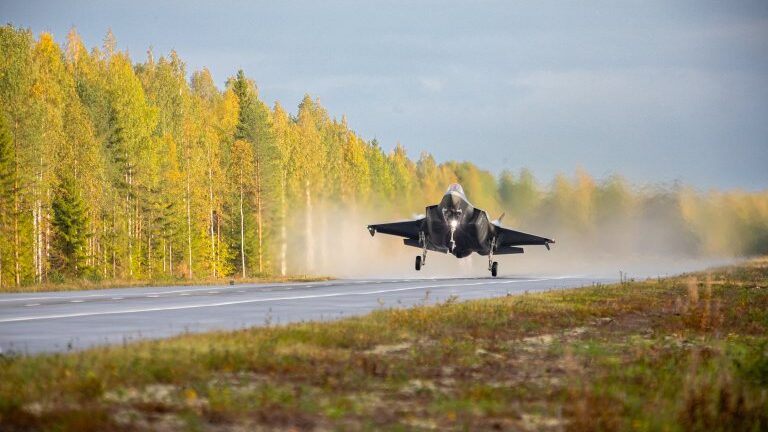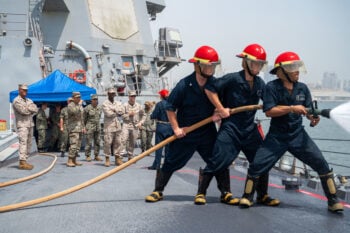
A Royal Norwegian Air Force F-35A fighter jet takes off from a highway in Finland for the first time (Norwegian Armed Forces)
BELFAST and WARSAW — On a cloudy day late last month, two F-35A Lightning fighters belonging to the Norwegian military glided in for a landing on a highway in central Finland — the first time the conventional take-off and landing variant of the jet had managed to land on a regular road.
The landing was on purpose, of course, part of an uptick in recent weeks of European militaries training for fighter jet landing and takeoff from highways in what analysts told Breaking Defense represents renewed interest in “dispersed” operations in the wake of Russia’s invasion of Ukraine. The goal: Give air forces the ability to operate more independent of and far from military bases and airfields that would be magnets for adversary attack.
“The aim of the concept is to make it more challenging for an enemy to take out our aircraft when on [the] ground,” said Chief of the Royal Norwegian Air Force Maj. Gen. Rolf Folland in a Norwegian Armed Forces statement at the time of the F-35A landing. “If such a concept is to work, we must map out all possibilities, and practice them.”
Swedish and Finnish armed forces already practice fighter jet operations from roads, but lately other European air forces have shown their own interest.
The Norwegian road landings and take-offs with the F-35 was part of the mutli-national exercise Baana, which also saw British Eurofighter Typhoon jets land and take off from a single-lane road, something one pilot described to the BBC as “pretty crazy.”
Last month also saw the Polish Air Force successfully complete a series of highway take-off and landings involving fighter jets, trainers and transport aircraft, during what’s known as the Route 604 dispersed operations training exercise in the small town of Wielbark in northern Poland.
“If you look at the Swedish or Finnish model of how they fly, they have a base area and within that they will have a number of strips, roads and airfields, that they can disperse [to] and operate,” said Gary Waterfall, a retired UK Royal Air Force (RAF) air vice-marshal. “They can get airborne from those sites, land at a different site, turn the airplane around, download, upload data, rearm, get airborne, and go at it again.”
He stressed that in “an era of ultra precision attacks” dispersed operations provides agility if base locations are under threat or airspace entry around the bases becomes denied by an enemy.
“Let’s say enemy strike plans are based around them going in and taking out a whole air wing at an airfield within a morning. Well that is not going to happen if they [friendly aircraft] are dispersed around the country and moving from A to B to C to D the whole time,” he said.
And beyond working out the practical kinks in road-based operations, analyst Justin Bronk said the exercises also send a message to a target audience to the east.
“The motivation behind the ops is partly to gather data on the opportunities and pitfalls of highway operations for air forces that have not done these in a long time, and partly to signal to Russia that they are taking serious steps to make their forces harder to target in a major war,” said Bronk, a senior research fellow for airpower and technology at the Royal United Services Institute, a UK defense think tank.
Similarly, Douglas Barrie, senior fellow for military aerospace at the UK-based International Institute for Strategic Studies, added that there is “a messaging element” aligned with the wave of newer highway training operations, amounting to NATO air forces telling Russia, “Don’t assume that just because you take out our main operating bases, you render my air force ineffective. This is all about compounding the targeting challenge for the other side.”
He added that Russia has discovered in Ukraine that “disabling” an enemy airfield, or the aircraft on it, is not a “straightforward task.”
Ultimately, said Waterfall, dispersed operations do not necessarily mean that air forces can prevent adversaries from targeting them but will “alter their calculus” around launching a strike or not.
Inside Poland’s Dispersed Ops Training
To Polish Air Force Inspector Maj. Gen. Ireneusz Nowak, the fighting in Ukraine has already proven the need to be able to operate aircraft far from their usual home.
Poland’s Exercise 604 specifically assessed the ability of F-16, Su-22, MiG-29, M-346, M28, C295M and C-130 air and ground crews to fly out of an alternate temporary installation, based on a scenario in which a home base was inaccessible. The exercise took place on Route 604, a public road used by car traffic everyday but temporarily closed for the event.
“Conclusions from Ukraine show that permanent airbases will be the first target of attacks,” Nowak told Breaking Defense. “When conducting a defensive operation, as is now the case in Ukraine, our air forces must be survivable. And this can be achieved by dispersing our aircraft, and that is what the DOLs [Drogowy Odcinek Lotniskowy, stretches of public roads designated as potential air strips] are for. An Agile Combat Employment concept requires the preparation of several dozen places [like DOL Wielbark] throughout the country.”
For the exercise, the highest ranking Polish fighter jet pilots were the first to conduct the public road take-offs and landings.
Dla nich Mission Impossible staje się Mission Possible! Dobre loty!
Inspektor Sił Powietrznych – gen. dyw. pil. Ireneusz Nowak, dowódca 2 Skrzydła Lotnictwa Taktycznego – gen. bryg. pil. Tomasz Jatczak, dowódca 4 Skrzydła Lotnictwa Szkolnego – gen. bryg. pil. Grzegorz Ślusarz,… pic.twitter.com/YPgHSajPzJ
— Dowództwo Generalne (@DGeneralneRSZ) September 25, 2023
Dziś z innej perspektywy. Podejście do lądowania na #DOL. W roli głównej: #C130 Herkules.
Trwa ćwiczenie Sił Powietrznych RP 🇵🇱 #Route604. pic.twitter.com/gwszKZC1fD
— Sztab Generalny WP (@SztabGenWP) September 28, 2023
“For several reasons, the commanders landed first … [mainly] to show good leadership,” said Polish Air Force Inspector Maj. Gen. Ireneusz Nowak. “I do not want, and I say this very clearly and decisively, in the Polish Air Force, commanders behind desks. In aviation, you quickly lose contact with what is happening in combat units and it is difficult to make the right decisions when you are only a Power Point specialist sitting at your desk in Warsaw.”
Over 40 pilots were trained on public highway operations over the course of the Route 604 exercise.
While the pilots learned their roles, air defenses also got a workout in “protecting” assets from mock enemy attack. Air defenders operating a Pilica VSHORAD missile and artillery system were trained, facing off against MiG-29 Fulcrums as “aggressors.” The exercise was also protected against terrorist, drone or enemy aircraft attack by the Pilica systems, having to also counter a TB2 Bayraktar UCAV as well as a S-70i Black Hawk helicopter.
Next year, the Polish Air Force expects to conduct public road night operations that could also involve newly acquired KAI FA-50GF trainer jets.
Expect Road Landings To Become More Common
Nowak said there was a “desire” for similar exercises to take place in Poland annually, and for other dispersed operation training exercises in collaboration with NATO partner air forces.
In the longer term, extensive international cooperation is expected, including collaboration with Scandinavian countries, well versed in dispersed operations. Pilots from other allied countries are also to be invited to Poland for exercises to jointly train and learn about how to operate in Polish conditions.
“In peacetime, exercises on motorways would involve the closure of important transport routes, and, in times of war, the same highways will constitute a very important element of the logistical supply of troops, which also excludes interruption, even only temporarily, of such important supply arteries,” explained Lt. Gen. Wiesław Kukuła, general commander of the Polish Armed Forces.
Poland’s commitment to modernize roads and collaborate with other NATO partners on dispersed operations in the future again points to heightening deterrence in the face of Russian aggression.
“There’s a degree of urgency across all of NATO to do this because Russia has provided a wake up call,” said Waterfall. “I think it is really good to see because the day you don’t want to do this is the day you have to do it.”
More generally, Barrie suggested that the increase in dispersed ops stands as a “sign of the times” because of Russia’s “pretty abrasive relationship” with Europe.
“I don’t think there’s any reason why we wouldn’t see air force’s look to improve resilience and survivability. In the NATO context people are going to look at every option,” he said.
TAI exec claims 20 Turkish KAAN fighters to be delivered in 2028
Temel Kotil, TAI’s general manager, claimed that the domestically-produced Turkish jet will outperform the F-35 Joint Strike Fighter.


























